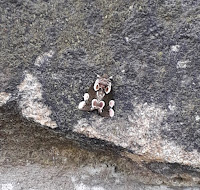Tuesday: The weather was good enough at 0600 for the nets to be opened at Nant Plantation. I went to see if there were any birds passing off the North West corner and to see if there were any more spikes of Autumn Lady's tresses. Sadly there were very few shearwaters and gulls and no more spikes of my favourite orchid. I walked to Nant to see how the ringers were doing. They had ringed a Robin, a Scouple of Spotted Flycatchers and a Wren. Some birds get expert at avoiding the nets, which meant we saw but didn't catch Tree Pipit and Pied Flycatcher. Managed a photo of the Flycatcher There were also some chough feeding not too far away. I saw one on the roof of one of the buildings
Back to Cristin for 9.00 am and toast and then checking the moth trap. This year I seem to be developing a knack of seeing moths away from the trap. The first one seen below is another Orange Swift I noted in the small shop. The second one is what I thought was a piece of white stone in the banking. It was right next to Lady's Bedstraw, so no surprise that it was Galium Carpet.
Walked round to the south end where I passed a Silver Y moth which would not keep still, so no photo. Fortunately many of the seals did not move around so energetically.
On Tuesday evening the Whale and Dolphin Conservation used a power point to inform us of their research about Risso's Dolphins in the waters around Bardsey.
Wednesday - After breakfast I walked through the fields to Solvach to look for more waders. I had decent views of Manx Shearwaters and Gannets as well as the Turnstones, a Dunlin and this Ringed Plover.
I then had a little doze on the beach listening to Sandwich Terns, Redshank and the inevitable Chough. Back to Cristin for tea and at long last seeing a couple of wheatears, as well as a Small Copper butterfly
Thursday was my day to walk up the mountain. I went via the farm so I could get a view of the large number of Autumn Lady's Tresses. One of the other reasons for making the climb is from this point I can get a signal on my phone to let my family know I am stll around
It's also close to a rare lichen that is found on Bardsey, the Golden Hair Lichen. teloschistes flavicans.
I also went on a search for one of the slow worms that live here. I always think it is wrongly named. Not only is it not a worm, In my experience it's not slow either. It's actually a legless lizard.
Not my best photo, but I didn't want to disturb him too much. After tea, many of us gathered in the schoolroom for a time of music. We had guitars, a banjo, a saxophone, a drum solo, some lovely singing from some of the young folk on the island, a solo dance, a reading of " The Battle of Hastings" written by Marriot Edgar, an Irish song performed by the Island Chaplain and a rendition by all present of " Ilkley Moor ".
Friday started off windy again so off to the North West corner for some sea watching. We did see a teal on Nant pond which is the first time I've seen this duck on Bardsey.
We don't just watch the sea, but note the birds that are hugging the coast as they fly past. Lots of Gannets, Kittywakes, Manx Shearwaters, Arctic and Sandwich Terns, the occasional Guillemot and a close view of a Great Skua. It was however much easier to photograph this linnet on nearby vegetation. I do include a photo of a bonxie with kind permission of Ben Porter
On my return to Cristin, I noted that the single spike of Autumn Lady's Tresses had been grazed by sheep. Moth trap checked again with this good example of a Flame Shoulder moth.
By afternoon the wind had subsided and the sun was out. Time for more lazing around on the beach. On my walk back to Cristin I had a final check on any flowers I had not recorded for this visit. The ones I always look for, apart from the orchids and samphire are Heath Groundsel and Scarlet Pimpernel. The latter, picture below, often as elusive as Sir Percy. After tea, Kevin, another of the Observatory volunteers showed me a creature I hadn't seen ever. It was a psuedo scorpion neobisium maritimum which had not been recorded on Bardsey before.
Some people ask me what I do on Bardsey. As you have seen, with birds, butterlies, moths, marine mammals, lichens, flowers and fantastic sunsets, it is my island paradise.








































